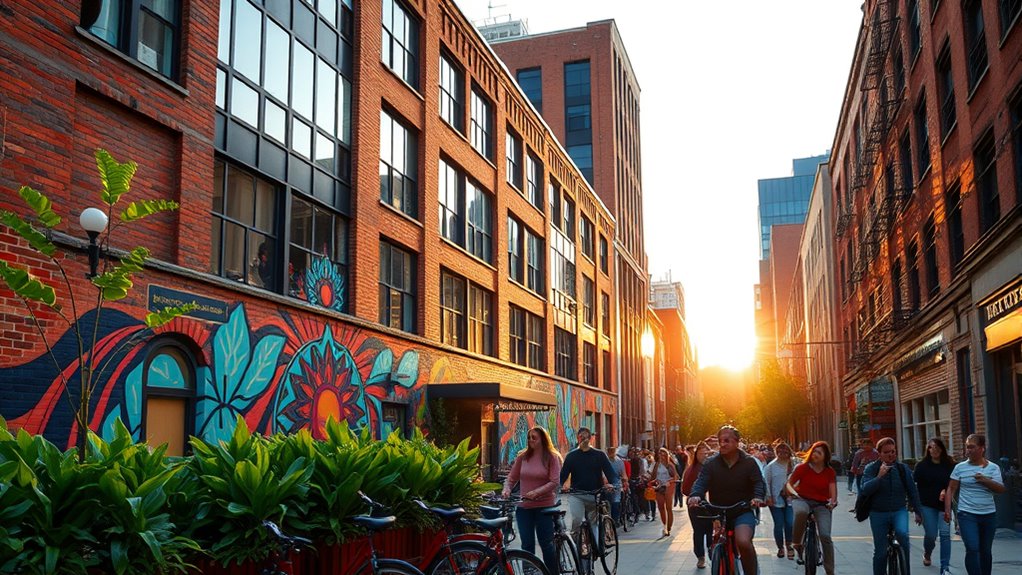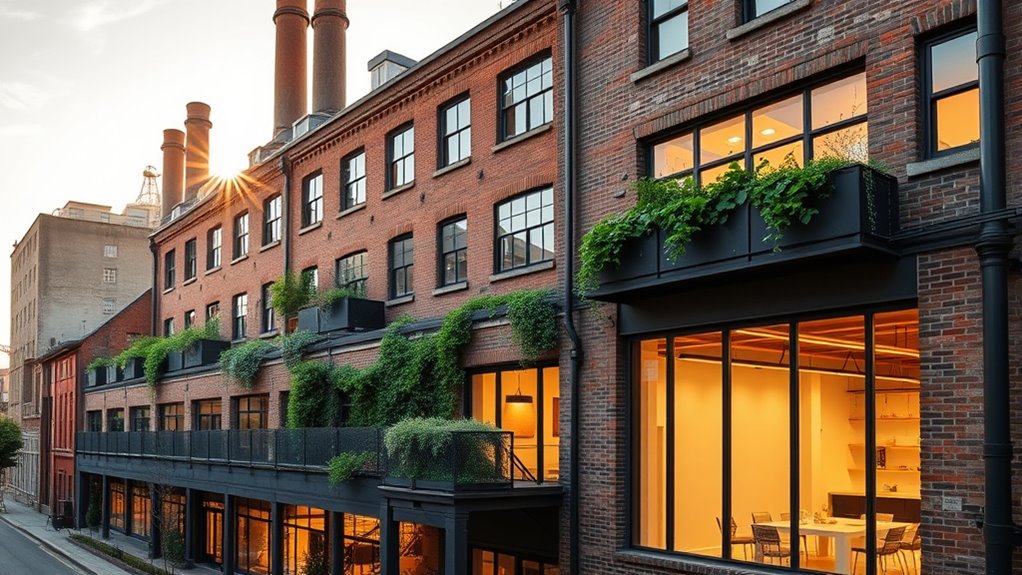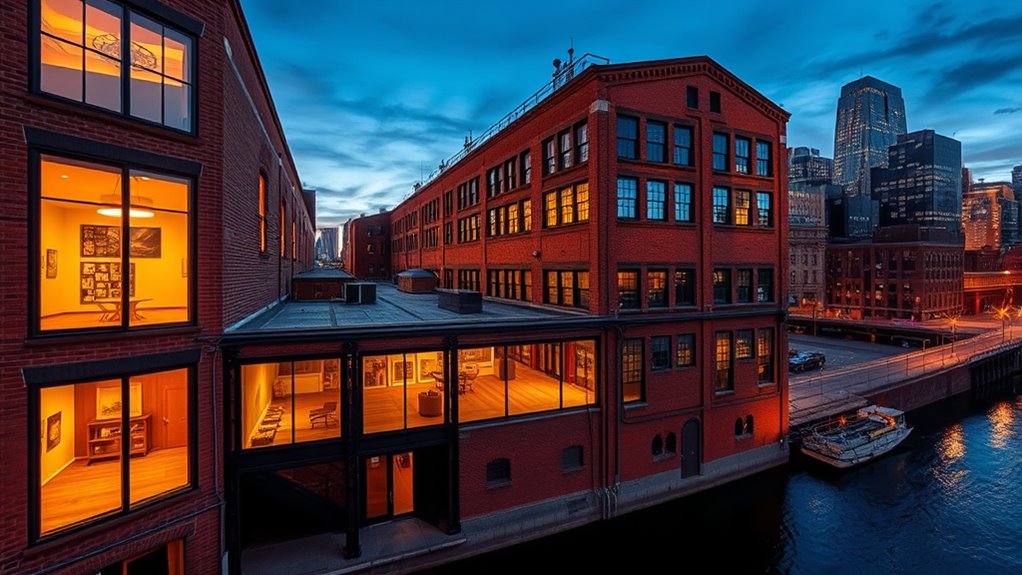Adaptive reuse transforms old buildings into modern gems by preserving historical charm while adding innovative, sustainable features. It benefits communities by boosting local economies, maintaining cultural heritage, and reducing environmental impact. Careful planning focuses on respecting original architecture, complying with regulations, and incorporating flexible, eco-friendly designs. Challenges like zoning or structural issues are overcome with creative solutions. Discover inspiring examples and key strategies that make this revitalization successful as you explore ways to turn history into vibrant, functional spaces.
Key Takeaways
- Preserving historic architecture maintains cultural identity while revitalizing communities and attracting visitors.
- Innovative design approaches, like modular layouts and sustainable materials, enhance functionality and aesthetic appeal.
- Addressing zoning and preservation guidelines ensures legal compliance and structural integrity during transformation.
- Successful projects, such as Tate Modern and The High Line, demonstrate the economic and social benefits of adaptive reuse.
- Early stakeholder engagement and flexible planning help overcome challenges and ensure project feasibility.
Benefits of Adaptive Reuse for Communities and the Environment

Adaptive reuse offers significant benefits for both communities and the environment by transforming old buildings into functional spaces rather than demolishing them. By emphasizing historic preservation, you retain the unique architectural character that tells a community’s story. This approach also fosters economic revitalization, attracting new businesses and visitors, which boosts local economies. Reusing existing structures reduces construction waste and minimizes environmental impact compared to new builds, supporting sustainability. It encourages community engagement by repurposing familiar landmarks and creating vibrant public spaces. Incorporating wall organization systems can further enhance the functionality and aesthetic appeal of these revitalized spaces. As a result, adaptive reuse preserves cultural heritage while revitalizing neighborhoods, making them more attractive and resilient. This blend of preservation and renewal not only benefits the environment but also fosters a sense of identity and pride among residents. Furthermore, integrating innovative artistic practices into these projects can elevate their cultural significance and community appeal. Additionally, implementing building codes and safety standards ensures these transformed structures meet modern requirements while maintaining their historic charm. Recognizing the value of community involvement can lead to more successful and sustainable redevelopment initiatives.
Key Elements in Planning a Successful Renovation

Successfully planning a renovation requires careful attention to several key elements that guarantee the project meets both functional and aesthetic goals. First, prioritize historic preservation to retain the building’s unique character while updating its structure. Understanding the importance of preserving architectural details can enhance the building’s charm and community value. Additionally, zoning regulations play a vital role; ensure your plans comply with local laws to avoid costly delays or modifications. Research any restrictions on land use, height, or historical designations early in the process. Collaborate with architects and planners familiar with adaptive reuse projects to align your vision with legal and preservation requirements. By balancing historic preservation efforts with zoning compliance, you set a solid foundation for a successful renovation that respects the past while serving modern needs. Incorporating building codes and safety standards into your planning can further ensure the longevity and legal compliance of your project. Moreover, understanding emotional alignment can help foster a collaborative and positive working environment throughout the renovation process. Recognizing the importance of prophetic dreams in guiding decision-making can also bring a unique perspective to creative problem-solving during complex projects. Additionally, integrating emerging technologies such as smart building systems can increase the sustainability and efficiency of the renovated space.
Innovative Design Approaches for Old Structures

Designing innovative solutions for old structures requires thinking beyond traditional renovation methods. You can enhance historic preservation while embracing modern needs by integrating creative design approaches. For instance, prioritize maintaining original features, then introduce flexible spatial layouts that adapt to various uses. Incorporate modular elements to maximize spatial flexibility without compromising the building’s character. This approach respects the building’s history yet makes it functional for today’s requirements. Think of combining preserved facades with open-plan interiors or movable partitions. Here’s a quick overview:
| Approach | Benefits | Examples |
|---|---|---|
| Historic preservation | Maintains cultural value | Restoring facades |
| Spatial flexibility | Allows multiple uses | Movable walls |
| Modular design | Easy reconfiguration | Prefabricated units |
| Light optimization | Brightens interior | Skylights & glass walls |
| Sustainable materials | Eco-friendly & durable | Reclaimed wood |
Implementing Tiny House principles can also inspire creative reuse strategies, blending small-scale living with adaptive design elements. These strategies help you create inspiring, adaptable spaces rooted in history. Incorporating adaptive reuse principles can also optimize economic and environmental benefits over time, especially when considering cost-effective renovation techniques that reduce waste and expense. Additionally, leveraging innovative design methods can further enhance the functionality and aesthetic appeal of restored structures.
Challenges and Solutions in Adaptive Reuse Projects

While adaptive reuse projects offer innovative ways to preserve and repurpose old structures, they often present significant challenges that require careful maneuvering. You might encounter strict zoning regulations that limit modifications or impose restrictions on new uses. Preservation guidelines also demand careful attention to maintain historical integrity, which can complicate design changes. Navigating these hurdles requires thorough research and collaboration with local authorities.
Key challenges include:
- Aligning project goals with zoning restrictions
- Balancing preservation guidelines with modern updates
- Securing permits and approvals
- Managing unexpected structural issues during renovation
Solutions involve early stakeholder engagement, detailed planning, and flexible design strategies. Addressing these challenges proactively ensures your adaptive reuse project remains feasible while respecting the building’s heritage.
Inspiring Examples of Transformed Architectural Landmarks

Have you ever wondered how old, abandoned buildings can be transformed into vibrant landmarks? These inspiring examples showcase the power of adaptive reuse, blending historical preservation with modern design. Take the Tate Modern in London, a former power station now a hub for art and culture. Or the High Line in New York, a repurposed elevated railway turned public park. These landmarks honor their cultural significance while reinventing themselves as community spaces. Visualize the transformation:
| Original Structure | Key Transformation | Modern Use |
|---|---|---|
| Power Station | Preserved facade | Art Museum |
| Railway Tracks | Green space | Urban Park |
| Historic Facades | Innovative design | Cultural Center |
| Industrial Warehouse | Adaptive interior | Shopping and Dining Area |
These examples prove that thoughtful adaptive reuse celebrates history while inspiring new generations.
Frequently Asked Questions
How Does Adaptive Reuse Impact Local Property Values?
You might notice that adaptive reuse often boosts local property values by promoting heritage preservation and neighborhood revitalization. When old buildings are transformed into modern spaces, it attracts new residents and businesses, making the area more desirable. This process preserves historic charm while revitalizing communities, which in turn can increase property demand and values. Overall, adaptive reuse benefits both the community’s character and its economic growth.
What Are Common Regulatory Hurdles in Adaptive Reuse Projects?
When you’re working on adaptive reuse projects, you often face regulatory hurdles like strict zoning restrictions that limit how you can modify properties. Historic preservation laws can also complicate your plans, requiring approvals for renovations to maintain a building’s heritage. Managing these regulations takes time and effort, but understanding them early helps you design solutions that respect preservation requirements while achieving your reuse goals.
How Do Adaptive Reuse Projects Secure Funding and Incentives?
To secure funding and incentives, you should explore tax incentives and public grants. Tax incentives, like historic preservation credits, can markedly reduce your project costs, while public grants provide funding support for adaptive reuse initiatives. You can apply through government programs and local agencies, demonstrating how your project benefits the community. Combining these financial tools makes transforming old buildings into modern gems more achievable and financially sustainable.
What Maintenance Challenges Arise After Adaptive Reuse?
After adaptive reuse, you’ll face maintenance challenges like ensuring structural integrity over time and preserving the building’s aesthetic appeal. You need to regularly inspect for wear and tear, especially in older structures not built for modern uses. Balancing the preservation of original features with updates for safety and functionality can be tricky. Staying proactive helps you address issues early, maintaining both the building’s charm and its structural soundness.
How Does Adaptive Reuse Influence Community Identity and Culture?
Think of a building’s history like a tapestry woven with community stories. Adaptive reuse acts as a bridge, blending historic preservation with new life, enriching cultural significance. You help preserve community identity by honoring old structures’ stories while giving them fresh purpose. This fosters pride and continuity, turning old buildings into vibrant symbols of shared history, where culture and modernity intertwine seamlessly, strengthening your community’s unique character.
Conclusion
By embracing adaptive reuse, you breathe new life into old buildings, benefiting both your community and the environment. With thoughtful planning and innovative design, you can transform these landmarks into modern gems that stand the test of time. Remember, “a stitch in time saves nine,” so addressing challenges early guarantees a successful project. When you give old structures a new purpose, you help preserve history while creating inspiring spaces for future generations.









